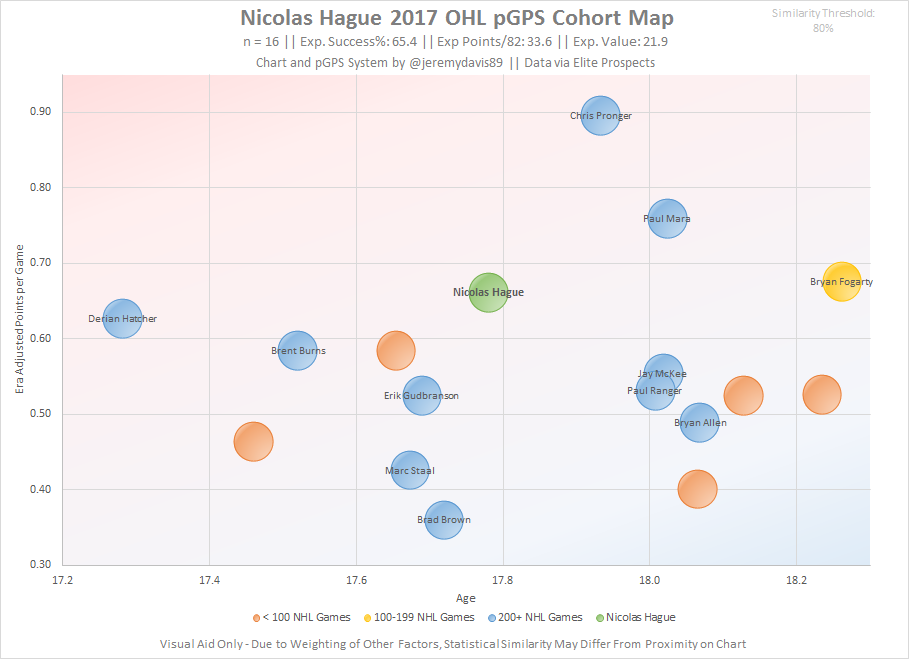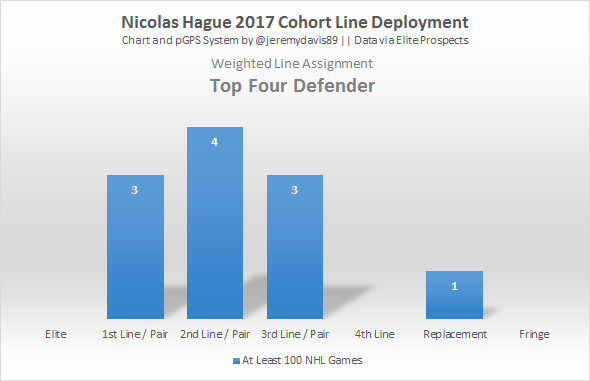Nation Network 2017 Prospect Profile: #19 – Nicolas Hague

By Garret Hohl
6 years agoEvery year there is a defender with a ton of size that most-to-all the scouts salivate over. However, historically speaking a lot of these defensemen have been some of the biggest historical busts.
At around 6’6 or 6’7, depending on where you ask, and well over 200 lbs, Nicolas Hague may be the largest defender in the 2017 NHL Entry Draft. But with 46 points in 65 regular season OHL games, he is no pylon by any means.
Hague comes in in at 19 in our Nation Network Prospect Profiles.
Bio:
- Age: 18-years-old, 1998-12-05
- Birthplace: Kitchener, ON, CAN
- Position: LD
- Handedness: Left
- Height: 6’7″
- Weight: 214 lbs
- Draft Year Team: Mississauga Steelheads
Stats:

| pGPS S | pGPS N | pGPS % | pGPS P/82 | Expected Value |
| 16 | 24 | 65.4 | 33.6 | 21.9 |
Scouts:
| NHL (CSS) | FUTURE CONSIDERATIONS | HOCKEYPROSPECT | MCKENZIE | MCKEEN’S | ISS | BUTTON | DRAFT BUZZ |
| 20 (NA) | 20 | 18 | 36 | 27 | 18 | 55 | 38 |
Hague is a fluid skater and can move the puck extremely well, enabling his team to create a lot of offense. He also has five power-play goals, second on Mississauga. The left-shot defenseman also is tough in the defensive end.
Plays in all situations, can anchor a PP. Some scouts think skating still an issue, others not that concerned about his feet. Very poised, well controlled now
Hague has a great mix of size, skating, and skill…shuts down the oppositions’ top lines and is a driver of the play…is physical and will give that extra shot to his opponent to leave a mark and an impression for the next time…doesn’t give his man room to breathe in front of the net…not shy with stepping in to lay the body, standing up his man with a solid check…controls the gap very well with strong position and good stick work…very balanced and surprisingly mobile for a big kid, he possesses a powerful lateral step.
Our Take:
Failed to load video.
Nicolas Hague is a big, powerful, and mean physical-type defender, which may cause some to think of Logan Stanley from last year’s draft. Unlike Stanley, though, there are aspects to Hague’s game that makes him a far safer, more interesting pick with higher upside.
There are some mix reviews on Hague’s skating, which is not abnormal for a 17-year-old above 6’2. Taller skaters tend to have ugly mechanics, especially at such a young age with little time to settle into their body. Hague much improved his skating since last year and –while he’s no Erik Karlsson– he can move the puck out of danger.
He has puck skills to distribute in the offensive zone and man the power play, but –much like Cal Foote before him– there is the issue with his transitional game that limits his potential. Hague overly relies on dump and chip plays to move the puck forward, which may be preferential over giving the puck away, but less marginally so than many tend to believe.

Hague produces most of his scoring at even strength, which is a positive sign for the future. Power play for defenders is an interesting variable, since being good enough to play on the power play is a good signal but being over reliant on the power play is a negative sign.
Using the SEAL scoring model, Hague was the sixth most productive first-time NHL draft eligible defender.
Another positive signal of future success was that Hague produced elite shot production numbers while consistently linematching against the other team’s best.

Hague is a fairly safe investment, as most large players get time to play to prove whether or not they can indeed play. I’m not certain that Hague has the offensive upside to be the next Brent Burns or Chris Pronger, but those statistical cohorts exist.
While he is an early birthday, he did produce relatively more for his age than most of his cohorts.

When we look at degree of similarity, we see that most of the close comparables are older players like Paul Ranger, Darian Hatcher, and Paul Mara. The more recent cohorts are a lot less like Hague, such as Erik Gudbranson and Marc Staal. This is because it is fairly rare for players to be as big and score as much as Hague has.

The bulk of Hague’s cohorts tended to be about league average defenders. If we are to take Hague’s pGPS at face value, this would suggest him being about a one-in-two shot of being a NHL skater, with a one-in-four shot of being a second pairing defender.
Any team will enjoy a second pairing defender drafted mid-to-late in the first round, but the lack of that dynamic flare limits the possibility of him hitting that Burns/Pronger type ceiling. There’s always that chance. Teams like a big, mean player that can skate.
An oversized defender with some offense will be get some teams really tempted to swing for the fences with Hague.
Recent articles from Garret Hohl





